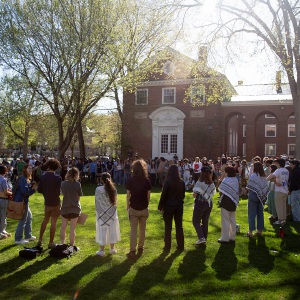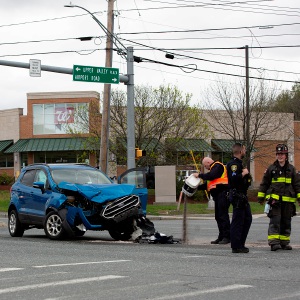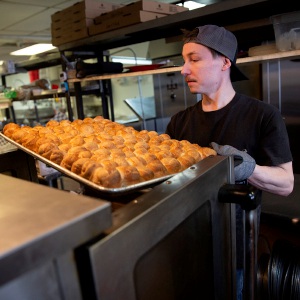Tunbridge bridge construction spurs rerouting for buses, fire trucks
| Published: 11-16-2023 4:08 AM |
TUNBRIDGE — Town and state officials are working to avoid disruptions to emergency services while conducting repairs on two separate bridges; work that needs to be completed before winter.
The possible simultaneous closures of both Strafford Road and Route 110 for construction presents hurdles for residents, emergency services and school buses. Those two roads fork north of Tunbridge. Closing both at the same time would pose access issues for first responders and especially firefighters, who rely on large vehicles that can only drive on main roads.
“Because of winter and (Federal Emergency Management Agency) deadlines, they’ve had to possibly close both roads at the same time in order to have them done in time to get paid for it,” Tunbridge Fire Chief Simon Bradford said.
The original plan was to have Strafford Road completed before the state started Route 110, Bradford said. That is still the goal, though the town did send out a notice warning both could be closed at the same time.
The Tunbridge town website announced in late October that Strafford Road would be closed from Oct. 30 to Nov. 20 to allow a contractor to replace the bridge located at the intersection with Hoyt Hill and Tuttle Road.
On Nov. 2, the town announced that the Vermont Agency of Transportation “will be closing Route 110 at Whitney Hill Road intersection to replace a bridge.” This additional closure is set to last from 6 p.m. on this Thursday until 6 a.m. next Tuesday.
In order to avoid overlapping closures, Strafford Road is slated to reopen to at least emergency vehicles on Thursday, a few days earlier than scheduled, according to the town’s website.
“The new pipe is almost assembled, so sometime between now and Thursday at 6 p.m., we’ll have it useable,” Matt Loftus, the contractor for the Strafford Road project, said.
Article continues after...
Yesterday's Most Read Articles
 Dartmouth administration faces fierce criticism over protest arrests
Dartmouth administration faces fierce criticism over protest arrests
 West Lebanon crash
West Lebanon crash
 Plan on track to ship Upper Valley mail to Connecticut for sorting
Plan on track to ship Upper Valley mail to Connecticut for sorting
 Lebanon’s Jewell back from auto accident, more aware of ‘drowsy driving’ dangers
Lebanon’s Jewell back from auto accident, more aware of ‘drowsy driving’ dangers
 Longtime employees buy West Lebanon pizzeria
Longtime employees buy West Lebanon pizzeria
That would ensure Strafford Road has reopened before Route 110 closes.
In the days leading up to and after Route 110’s closure, there will be alternating one-way traffic across Strafford Road’s Bridge 6. But during bridge construction, Route 110 “will be fully closed,” Jonathan Griffin, a Barre-based project manager for VTrans, said in an email.
“In the event of an overlap of closure, we will not close our bridge (Route 110) until we know that an emergency service vehicle can make it across the Stafford Road construction site,” Griffin wrote in an email.
“Now, whether that means that they’re completely done, and they’ve opened it to the public — I’m not sure. But it would at least be open to an emergency service vehicle in case there was an emergency,” Griffin said on the phone.
The town already has had to coordinate with its neighbors to ensure that all residents have access to emergency services. Currently, part of the town is inaccessible for Tunbridge’s larger emergency vehicles.
Covered bridges restrict access to the northern quarter of town, Bradford said. As a result, Chelsea is covering that portion of Tunbridge, he said.
“We’ve had to rely on them and Strafford to cover this quarter of the town,” he said. “So, one road closure isn’t a big problem because we have an ambulance coming in from both sides.”
Damage from summer flooding has forced the repair of outdated bridges, the cost of which will be covered by federal funding.
The Route 110 project is expected to cost about $1 million and be “100% federally funded” by the Federal Highway Administration, Griffin wrote in an email.
FEMA is the other major funder of projects since the floods. It has been “involved right from the very beginning” of the Strafford Road project, which is expected to cost about $350,000, said Brenda Field, Tunbridge’s emergency director.
“It’s an inconvenience for all of us, but it’s necessary,” Bradford said of the construction. “There’s no quick, easy bypass that could be put in to be able to make the projects happen before winter.”
For the time being, people are using back roads to get through Tunbridge, Bradford said.
“People have been posting on Facebook: ‘If you use this road to this road to this road, you get there,’ ” he said.
Field said the closures have been hardest on the school, which is trying to figure out bus routes.
Jamie Kinnarney, the superintendent of schools for the White River Valley Supervisory Union, which includes the First Branch Unified District composed of Tunbridge and Chelsea, said in a phone interview that the closure “impacts of course, our Chelsea and Tunbridge schools, but it also impacts our high school (the White River Valley High School in South Royalton) because we have a lot of choice students who come down the 110 corridor.”
Student Transportation of America “has been working on this for us for almost three or four weeks now,” Kinnarney said. “We’re feeling really confident that we’re gonna be able to serve our riders at 95% of our ridership.”
The changes, which include using back roads, will involve a 20-minute adjustment in drop-off times for some riders, and for a few stops, alternative transportation in smaller vehicles may be used to provide services for three different families, Kinnarney said.
Meanwhile, local business owners aren’t too worried about the bridge construction.
“I suspect it might be similar to when we had the flooding,” Michael Gross, one of the owners of the North Tunbridge General Store, said in a phone interview. “Businesswise we fared okay — I suspect we’ll be okay through this time because people can still get around on (the back roads).”
He noted that the bridge has to be fixed. “And they’ll do the best they can to get it open quickly, so we’ll just do what we can,” he said.
People also are caring for their fellow Vermonters through any logistical challenges.
“One of the unforeseen things is that nice things are happening too,” Field said. “We have people in town here coming up trying to help the road crew.”
Community members also are looking forward to what the new bridges will mean for the future.
“The old bridge (on Strafford Road) was put in when there were horses and buckboards (or carriages), so I think this is really going to help,” Field said. “It’s a lot wider; a lot stronger, and the trucks are a little heavier than the (teams of) horses.”
Lukas Dunford can be reached at lukas.a.dunford.25@dartmouth.edu.





